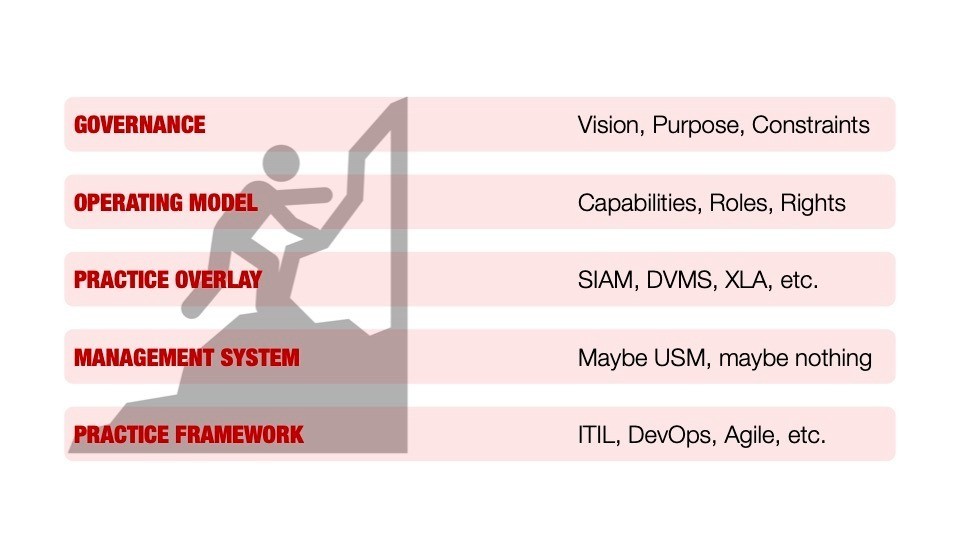A post by our guest editor, John Worthington.
Let’s get something out of the way right up front. While many of the examples in this series draw from IT—because that’s where service management frameworks have historically taken root—USM is not an IT framework. It’s a universal management system that applies to any service domain.
Whether you’re running a hospital, a university, a finance department, or a municipal helpdesk, the same structural logic applies. Why? Because all services are managed the same way—if you simplify to the system level.
Part 1: Why You Can’t Strategize Your Way Out of Execution Failure
“There is no honest way to explain the edge because the only people who really know where it is are the ones who have gone over it.” — Hunter S. Thompson
It starts with good intentions.
A group of leaders huddle around a whiteboard, sharpies in hand, mapping out their 'Operating Model'. It's all there: Governance. Strategy. Value Streams. Boxes and arrows. The obligatory nod to Agile. Some call it 'target state'; others say 'transformation roadmap'.
At the top of the diagram: Governance. The mountaintop. Where policies live, where vision is forged, where values supposedly cascade like gentle waterfalls into the hearts of teams below.
At the bottom, in smaller boxes, is the realm of practices—ITIL, DevOps, Agile, SAFe, XLA—tools and templates to get stuff done. Somewhat optional, often misunderstood, usually inherited.
Somewhere in the middle sits a label: Management System. No arrows in. No arrows out. Just there. Like a side note. Like an afterthought.
🎭 The Illusion of Altitude
Here’s the lie most organizations tell themselves—sometimes quietly, sometimes with great fanfare:
"If we get the governance right, the execution will follow."
But strategy doesn’t execute itself. Overlays don’t enforce themselves. And no matter how visionary your policies are, they can’t be acted upon unless they are translated into system behavior.
Most orgs have great ideas. Many have compelling governance. A few even have slick PowerPoint operating models.
But most lack the thing that makes all the layers work together:
👉 A real management system.
🔺 A Common But Flawed View
Let’s look at how most organizations conceptualize their service management hierarchy:

It looks solid. But it’s not.
The flaw? 👉 They treat this as a ladder—a prestige pyramid. Everyone wants to be higher up. Governance becomes the goal. Practices become the grunt work.
But here’s the truth:
Every layer matters. But only the management system binds them together.
⚙️ The Management System Is the Missing Link
A real management system isn’t a tool. It’s not a framework. It’s not a process catalog.
It’s the structural architecture that:
- Defines your key organizational profiles
- Standardizes your process logic
- Creates repeatable workflows
- Links governance to execution
- Allows for recursion across providers and domains
Without it:
- Governance is a suggestion
- Overlays are glue on sand
- Practices become siloed rituals
A management system doesn’t just exist between the layers—it connects them. It’s not a ladder rung. It’s the load-bearing spine.
🔍 Coming Up in Part 2:
We’ll take this further and break down what each layer really does—governance, overlays, operating models, practices—and why most people mix them up.
We’ll also explore why frameworks like ITIL and SAFe can’t run your enterprise, and why USM might be the system you didn’t realize you were missing.
💬 Sound Familiar?
If you’ve ever been caught in the space between strategic plans and daily fire drills... If you’ve watched consultants draw beautiful models that never become reality... If you’ve implemented a dozen “best practices” but still feel stuck...
You're not alone.
The mountain isn’t the problem. The lack of a path that connects its base to its summit is.
Let’s fix that.
==/==
![]() If you enjoyed John's post and it made you think about improving your own organization, please check out his USM Professional profile and his personal website, or better: contact John for a free consultation.
If you enjoyed John's post and it made you think about improving your own organization, please check out his USM Professional profile and his personal website, or better: contact John for a free consultation.
John has posted this blog earlier in his USM method News LinkedIN newsletter. If you want to read his posts when they're published - subscribe to John's channel.

